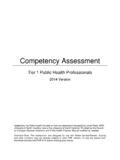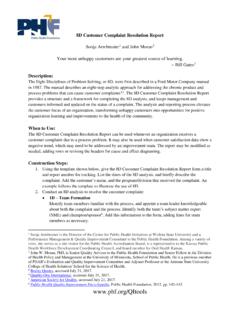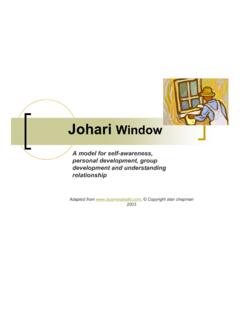Transcription of Scoring The Tuckman Team Maturity Questionnaire …
1 1 Scoring The Tuckman team Maturity Questionnaire Electronically Erin Barkema1 and John W. Moran2 October 2013 Description: The Forming Storming Norming Performing model of group development was first proposed by Bruce Tuckman in 1965, who maintained that these phases are all necessary and inevitable in order for the team to grow, to face up to challenges, to tackle problems, to find solutions, to plan work, and to deliver Today public health departments are employing the teaming concept on a regular basis to make quality improvements to their critical processes.
2 team leaders and managers need to understand how teams mature and when to intervene when things are not progressing as desired. When to Use: The purpose of the Tuckman Model is to identify and understand what stage of the teamwork that a team is operating in. It can be used at any point in the teaming process to build awareness of how the team s Maturity and develop strategies to move it forward. The team is administered a Questionnaire containing statements about Each team member scores each of the 32 questions using the following scale to indicate how often their team displays each indicated behavior.
3 1 Erin Barkema, MPH is a consultant to the Public Health Foundation and a Regional Community Health Consultant for the Bureau of Local Public Health Services at the Iowa Department of Public Health, and part-time faculty in the Master of Public Health program at Des Moines University. 2 John W. Moran, MBA, , CMC, CQIA, CMQ/OE, is a Senior Quality Advisor to the Public Health Foundation and a Senior Fellow at the University of Minnesota, School of Public Health in the Division of Health Policy and Management.
4 Vice-President of the Advisory Board of Choose To Be Healthy Coalition for York County, Maine, 2011 present, and a faculty member of the CDC/IHI Antibiotic Stewardship project 2011-2012. He is a member of the PHAB QI and Evaluation Committee and Adjunct Professor in the Arizona State University School of Health Sciences. 3 's_stages_of_group_development, accessed 5/19/2013 4 ~donclark/ , accessed 10/1/2013 Response Scale 1 - Almost never 2 Seldom 3 Occasionally 4 Frequently 5 - Almost always 2 Questionnaire : 1.
5 We try to have set procedures or protocols to ensure that things are orderly and run smoothly ( minimize interruptions; everyone gets the opportunity to have their say). 2. We are quick to get on with the task on hand and do not spend too much time in the planning stage. 3. Our team feels that we are all in it together and shares responsibilities for the team 's success or failure. 4. We have thorough procedures for agreeing on our objectives and planning the way we will perform our tasks.
6 5. team members are afraid or do not like to ask others for help. 6. We take our team 's goals and objectives literally, and assume a shared understanding. 7. The team leader tries to keep order and contributes to the task at hand. 8. We do not have fixed procedures, we make them up as the task or project progresses. 9. We generate lots of ideas, but we do not use many because we fail to listen to them and reject them without fully understanding them. 10. team members do not fully trust the other team members and closely monitor others who are working on a specific task.
7 11. The team leader ensures that we follow the procedures, do not argue, do not interrupt, and keep to the point. 12. We enjoy working together; we have a fun and productive time. 13. We have accepted each other as members of the team . 14. The team leader is democratic and collaborative. 15. We are trying to define the goal and what tasks need to be accomplished. 16. Many of the team members have their own ideas about the process and personal agendas are rampant. 17. We fully accept each other's strengths and weaknesses.
8 18. We assign specific roles to team members ( team leader, facilitator, time keeper, note taker, etc.). 19. We try to achieve harmony by avoiding conflict. 20. The tasks are very different from what we imagined and seem very difficult to accomplish. 21. There are many abstract discussions of the concepts and issues, which make some members impatient with these discussions. 22. We are able to work through group problems. 23. We argue a lot even though we agree on the real issues. 24.
9 The team is often tempted to go above the original scope of the project. 25. We express criticism of others constructively. 26. There is a close attachment to the team . 27. It seems as if little is being accomplished with the project's goals. 28. The goals we have established seem unrealistic. 29. Although we are not fully sure of the project's goals and issues, we are excited and proud to be on the team . 30. We often share personal problems with each other. 31. There is a lot of resisting of the tasks on hand and quality improvement approaches.
10 32. We get a lot of work done. 3 Scoring : Once the Questionnaire is scored by each team member the next step is to transfer all the scores that were given for an item on the Questionnaire to the score sheet below. When you have entered all the scores for each question, total each of the four columns. Forming Stage Item Score Storming Stage Item Score Norming Stage Item Score Performing Stage Item Score 1. _____ 2. _____ 4. _____ 3. _____ 5. _____ 7. _____ 6. _____ 8. _____ 10. _____ 9. _____ 11.










